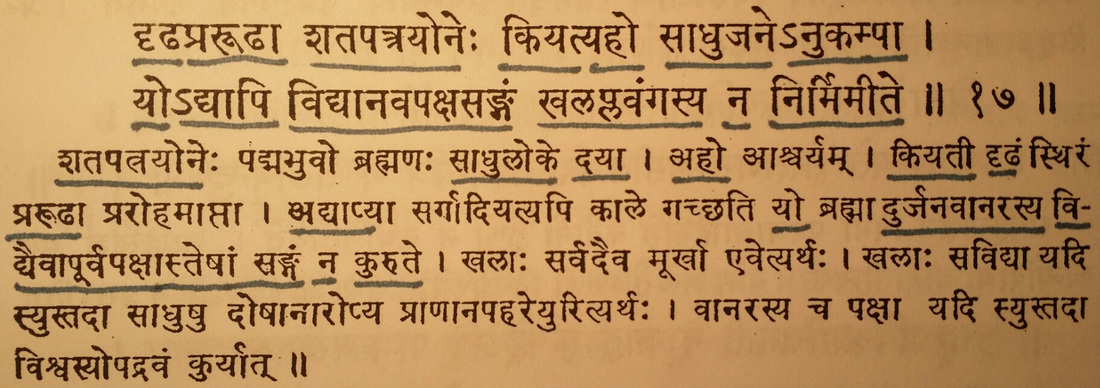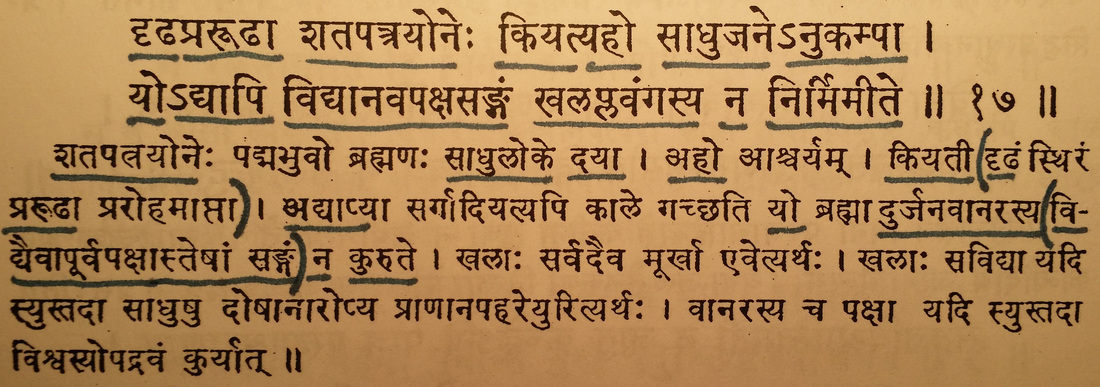Commentary
First year students can ignore this page. It is intended for students starting out in commentary in their second year.
What follows is a quick and dirty introduction (by way of example).
See Scholastic Sanskrit for a proper one.
See Scholastic Sanskrit for a proper one.
-
Introductory
-
Markup
-
Syntax / Analysis
-
Translation
-
Editing Texts
<
>
In one common style of commentary on verse poetry, the commentator will often first give a prose reordering of the verse in standard syntax (the anvaya, “connected order” of the sentence). This word-reordering does a great deal of work for you in construing the meaning of any particular verse. We can break that work down into two sets of commentarial functions: (1) it will:
- often break up sandhi, identifying words for you
- break up compounds (and other complex forms), identifying their meaning and type (or derivation) for you
- and of course reorganize the verse in intuitively meaningful syntax
- often gloss and grammatically derive various words
One of the best ways to see both sets of commentarial functions in action is to underline the verse’s words in the commentary. This is not always a straightforward matter as commentators will often use a synonym to stand in for a word in the verse. Here is an example of a verse (from the श्रीकण्ठचरित-महाकाव्य of मङ्ख) whose words (or their synonym stand-ins) have been underlined both in the verse (in larger font) and in Jonarāja’s simple commentary (in smaller font below it):
Jonarāja has used the following synonyms for words in the verse, saving himself the work of subsequently glossing them:
- साधु-लोके in the commentary = साधु-जने in the verse; similarly,
- दया = अनुकम्पा
- दुर्जन-वानरस्य = खल-प्लवंगस्य
- अपूर्व-पक्ष = नव-पक्ष
- कुरुते = निर्मिमीते
- The words in the verse itself were underlined at the same time in order to show whether the commentator left any words out of his comment and/or whether we may have missed any along the way.
- Entire vigrahas are underlined, so we don’t mistake the nominatives in them for the subject (its qualifiers, etc.) of their clause in the verse. Remember that compounds are primarily analyzed as consisting of two members. So, for longer compounds तत् is often used to stand for the last member of the 2-member compound just analyzed in order to relate it to the next member of the larger compound. For example, for the vigraha of XYZ compound, we might see X Y vigraha, then (Y=)तत् Z vigraha where तत् stands for Y. In the vigraha above, विद्या एव अपूर्वपक्षाः तेषां सङ्गम् (“the unprecedented wings that are knowledge; an attachment to them,” i.e., X एव Y, (Y=)तेषां Z), तेषाम् stands for अपूर्वपक्षाः, to relate it to सङ्गम्.
In addition to underlining vigrahas, it’s also useful to clearly demarcate them in some way. A highlighter could work here, but I’ll keep it simple and just use parentheses to display their extent, including 1) the use of तत् to reinsert them back into the anvaya’s syntax as well as 2) any glosses. (प्ररोहमाप्ता below is an example of the latter. An example of the former would be सङ्गः तं rather than the सङ्गं we find below.)
Reading just the underlined commentary permits us to read the verse (if sometimes through its synonyms) in an intuitive syntax (vigrahas in red):
- शतपत्त्रयोनेः साधुलोके दया अहो कियती दृढं प्ररूढा,
अद्यापि यो दुर्जनवानरस्य विद्यैव अपूर्वपक्षाः तेषां संगं न कुरुते ।


